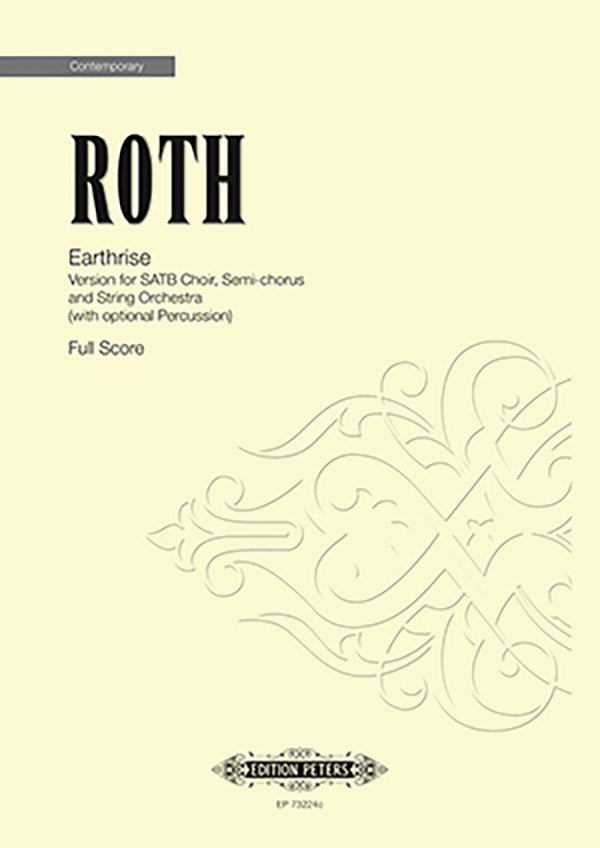Alec Roth
Roth: Earthrise
Version for SATB, Semi-chorus and String Orchestra (opt. Percussion)
- Composer: Alec Roth (1948-)
- Format: Full Score
- Instrumentation: SATB Choir, String Orchestra
- Work: Earthrise (Version for SATB Choir, Semi-chorus and String Orchestra (with optional Percussion))
- Work Language: English
- ISMN:
- Pages: 68
Description
Although suitable for large choirs with string orchestra, this version of Earthrise is also effective for small forces. with one-to-a-part, it may be performed by 12 singers and 5 players.
'Once a photograph of the Earth, taken from the outside, is available, a new idea as powerful as any in history will be let loose.' The astronomer Fred Hoyle's 1948 prophecy was fulfilled just twenty years later. The photograph was taken on 24 December 1968 and brought back to Earth by the astronauts of the Apollo 8 mission. The image, captioned 'Earthrise' caused a world-wide sensation on its publication early in 1969. Its influence on the nascent environmental movement was immediate and profound. The picture of our small blue planet in the vast darkness of space showed clearly its beauty, but also its vulnerability:
'It was the most beautiful, heart-catching sight of my life . . . raging nationalistic interests, famines, wars, pestilence don't show from that distance.' (Frank Borman, Apollo 8)
'It suddenly struck me that that tiny pea, pretty and blue, was the Earth. I put up my thumb and shut one eye, and my thumb blotted out the planet Earth.' (Neil Armstrong, Apollo 11).
According to that great prophet of our own day, the 'Gaia theory' scientist James Lovelock, man's hubristic claim to dominion over the Earth has led us to the brink of environmental catastrophe. He insists that if we are to come to a true appreciation of the damage we are doing, appealing to reason is not enough. We must develop an emotional connection to the Earth 'by harnessing the power of metaphor and myth, ancient wisdom and sacred texts'.
The astronauts' words find extraordinary parallels in the prophet Isaiah's evocation of a God's-eye view of the Earth: "Lift up your eyes on high and see. Who has measured with three fingers the form of the Earth? He that sits high above the globe of the Earth. Look, the nations are like a drop in a bucket! Look, the islands are like a fine dust!" These, together with other visionary words from ancient sources, provide the text for Earthrise , which is sung in Latin.
Throughout his writings Lovelock pays tribute to the importance of the Earthrise image: 'Can there have been any more inspiring vision this century than that of the Earth from space? We saw for the first time what a gem of a planet we live on. The astronauts who saw the whole Earth from Apollo 8 gave us an icon'. The music of Earthrise is a meditation on this icon and falls into three sections:
Part 1 – Man's constant drive to explore and exploit
Part 2 – Contemplation of the Earth seen from space
Part 3 – A plea for true wisdom and understanding
Publishers use a lot of words to describe what they sell, and we know it can be confusing. We've tried to be as clear as possible to make sure you get exactly what you are looking for. Below are descriptions of the terms that we use to describe the various formats that music often comes in.
Choral Score
A score for vocalists that only contains the vocal lines. The instrumental parts are not there for reference. Generally, cheaper than a vocal score and requires multiple copies for purchase.
Facsimile
Reproductions of the original hand-written scores from the composer.
Full Score
For ensemble music, this indicates that the edition contains all parts on a single system (there are not separate parts for each player). In larger ensembles, this is for the conductor.
Hardcover
Hardbound. Generally either linen-covered or half-leather.
Orchestral Parts
Similar to a wind set, this is a collection of parts. In the case of strings, the numbers listed are the number of copies included, though generally these are available individually (often with minimum quantities required).
Paperback
When publishers offer multiple bindings (e.g. hardcover) or study scores, this is the "standard" version. If you're planning to play the music, this is probably what you want.
Performance / Playing Score
A score of the music containing all parts on one system, intended for players to share. There are not separate parts for each player.
Set of Parts
For ensemble music, this indicates that there are separate individual parts for each player.
Solo Part with Piano Reduction
For solo pieces with orchestra, this is a version that contains a piano reduction of the orchestra parts. For piano pieces, two copies are typically needed for performance.
Study Score
A small (think choral size) copy of the complete score meant for studying, and not playing. They make great add-ons when learning concertos and small chamber works.
Vocal Score
A score prepared for vocalists that includes the piano/organ part or a reduction of the instrumental parts.
Wind Set
For orchestral music, this is a collection of wind and percussion parts. The specific quantities of each instrument are notated.
With Audio
In addition to the printed music, the edition contains recordings of the pieces. This may be an included CD, or access to files on the internet.
With / Without Fingering (Markings)
Some publishers prepare two copies - a pure Urtext edition that includes no fingering (or bowing) suggestions and a lightly edited version that includes a minimal number of editorial markings.




